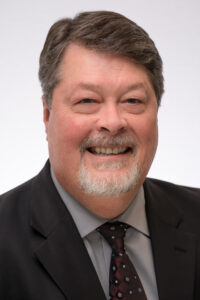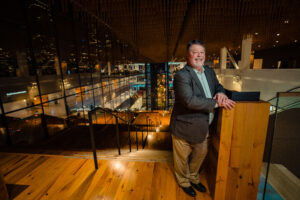It was a confluence of occurrences — contract expiration, expansion project completion, a successful opening year, and turning 68 in April —that prompted Jeffrey A. (Jeff) Blosser, president and chief executive officer of the Seattle Convention Center (SCC), to announce his retirement effective May 31.
“The timing feels good,” Blosser told Venue Professional. “I’ll be around the first five months [of 2024] to help with the transition.”

Jeff Blosser. SCC – Photo by Alabastro Photography.
An active member of IAVM since 1982 and having helmed the Seattle venue for 12 years, following John Christison, Blosser has seen the center through many changes. The most recent was completion of the 570,290 sq. ft. Summit building, which boasts 248,450 sq. ft of exhibit space, and when combined with the existing 434,988 sq. ft Arch building (205,700 sq. ft. of exhibit space), means 450,000 plus sq. ft. of exhibit space for SCC and the ability to attract new business.
“The issue is not to be bigger. What we do best is the 3,000-person convention, and now, we can do it twice, one moving in and showing, one moving out,” Blosser said. “It’s about making sure we have the right number of events and right number of people. The convention business is heads in beds and generating the tax, but we did $43 million in revenues in the building last year, and we will do more next year.”
SCC is run by the Washington State Convention Center Public Facilities District (PFD), which is responsible for its own debt — land purchasing, bonding and financing — as well as operating expenses. “It’s a different organization now with the new building,” Blosser said. SCC is now a $2-billion venue.
He surmised the SCC’s Board of Directors’ Search Committee, which has just begun to meet, could split his job into two parts – the PFD side of financing and politics, and separately, operations. However, it’s a process, and he has no idea what they will ultimately do.
Crediting 42 years of networking at IAVM with a lot of his career trajectory, Blosser said, “For me, IAVM has always been about the ability to get help from somebody or give somebody help. You can pick up the phone and call any building in the country, and they answer the phone and help out. While buildings may be competitive, we are more about making sure the building operations are as solid as they can be.”
His career has been heavily influenced by IAVM heavyweights like Tom Mobley, Peggy Daidakis, Dan Graveline, Frank Poe, and Roger Dixon, “who was the first one who hired me. But I could talk to anyone – John Adams, Dick Shaff, and they’d give you information. The biggest scenario for improving my capabilities in this industry has been those connections, the camraderie and the professionalism of the association.”
He gave back on the Convention Center Committee for six or seven years, helping work on white papers on booking and relationships with CVB’s. He was on the IAVM Board, repping convention centers for two terms, and he was involved in the Industry Council – lobbying to solve issues around the industry – for five or six years. Blosser received the Lifetime Achievement Award from IAVM’s Convention Center Sector in 2019.

Jeff Blosser. SCC
“It is important for our industry to have a bigger say on things that we can activate or are being acted on to us. We’re in a good spot today with more lobbying efforts at all levels — states, cities and nationally.” Blosser is particularly impressed with the safety and security efforts and IAVM’s Director of Safety & Security Mark Herrera’s collaborations and educational outreach. “It’s a different organization in a lot of ways,” he believes.
With the help of “the best team in the country,” including VP and AGM Linda Willanger, Blosser has seen a lot of changes at SCC. Getting through COVID, more detrimental to our industry than anything he can remember, was a turning point.
He has also been a leader in sustainability issues, proud that SCC’s new Summit building is LEED Platinum, as is his prior haunt, Oregon Convention Center, Portland, which he helped open in 1989, then expanded, before leaving for Seattle in 2011. “I cut my teeth on sustainability issues. We continue to stress that. I think the Pacific Northwest is ahead of everybody.”
Blosser started his career in what was called District 2 (now Region 2), when he worked for the Kentucky Fair and Exposition Center, then the downtown convention center, and then both state buildings as GM. He grew up in Southeast Ohio, attending Ohio University.
“I was relatively young back then. Watching the dynamics [of IAVM gatherings] was pretty fun,” he recalled. “It’s been a great ride. I’ve enjoyed all the relationships with people in this industry – suppliers, food service companies (Randy Ziegler comes to mind with Fine Host), Aramark. Smart Cities, Edlens. This business is so much fun. I won’t miss the hours, but I will definitely miss all of the people. I couldn’t have done anything better than what I did.”
Blosser plans to stay in Seattle and chase six grandkids, spend more time with family, and improve his handicap, basically “doing nothing” for six months. “I can do what I want, when I want. You can’t beat this place [Seattle] in the summertime.
